Updated on June 19, 2024 by Angelika
Weimar's attractions are set against the backdrop of cultural highlights and the greatest barbarism in human history. The bell tower of the Buchenwald Memorial on the Ettersberg is visible from afar and reminds city residents and visitors alike that the Nazis once built the largest concentration camp on German soil in the city of the classics.
I visited Weimar for the first time in 2021 during my Road trip from Eisenach to Berlin and was so enthusiastic that I went there again for four days in May 2023.
Few cities in Germany can boast two great UNESCO World Heritage Sites With the world heritage sites "Classical Weimar" and "Bauhaus and its sites in Weimar, Dessau and Bernau", Weimar has two real high-flyers. Moreover, it is one of the most beautiful cities in Germany!
I have to admit that I found it difficult to prioritize Weimar's attractions. Therefore, I decided to base the ranking on the importance that these places have, in my very personal opinion, for German culture and history.
If you want to learn about the many facets of German history, go to Weimar!
Weimar Sights - City Walk for 1 Day (with Map)
If you only have one day to explore Weimar, you can explore the main highlights of the city center with this walking tour I've worked out for you. You have enough time to visit Goethe's Residence and Duchess Anna Amalia Library .
If you have the Bauhaus Museum and/or the Buchenwald Memorial, you should plan for at least one to two extra days .
Tip: Reserve tickets for Goethe's Residence and the Duchess Anna Amalia Library online in advance. In this case, you must choose a 15-minute time slot for admission.
Start your tour at Frauenplan, where you can visit Goethe's Residence and (if your time permits) also the exhibition "Lebensfluten - Tatensturm".
You can download the route for your city tour to your cell phone. How to do that, I explain in my detailed blog post Plan Route with Google Maps. Note: For a better overview, you can hide individual layers of the map and, for example, only display the route for the tour.
For your tour of downtown Weimar, I recommend the following order:
A. Frauenplan (Goethe's residence)
B. Schiller Street (Schiller's residence)
C. Theaterplatz (Goethe-Schiller Monument, German National Theater, House of the Weimar Republic, Wittumspalais)
D. Herderplatz (Herder Church, Herder's residence)
E. City Palace
F. Goethe's Gartenhaus (from here you can walk to the Haus am Horn in 4 minutes!)
G. Templar House (within a few meters you can find the Shakespeare Monument, the Park Cave and the Liszt House)
H. Duchess Anna Amalia Library (visit rococo hall!)
I. Market Square (Tourist Information, Lucas Cranach House, Hotel Elephant, City Hall, Neptune Fountain)
J. The end of the city tour is again the Frauenplan, where you can rest and have a drink or meal, for example in Goethe's favorite inn "Gasthaus zum Weißen Schwan").
From Frauenplan it is about a 10-minute walk to the Historical Cemetery with the Ducal Vault - definitely worth the detour!
Weimar's Most Important Sights
1. Goethe's Residence (Goethe National Museum)
You should definitely not miss the Goethe House on the Frauenplan! Goethe is probably THE great German that most German citizens - regardless of political persuasion, whether young or old, whether they grew up in East or West - can agree on. In this magnificent house, which the prince of poets lived in for almost 50 years until his death in 1832, you can immerse yourself in Goethe's world of thought and his wide-ranging interests.
In 1782 Goethe rented the western half of the baroque house built between 1707 and 1709 by the hosier Helmershausen. After returning from his Italian trip in 1788, he lived in these rooms until 1789, but then moved in with his mistress and later wife Christiane Vulpius into a house on Marienstrasse.
In 1792 Duke Carl August bought the house and left it to Goethe as official residence, which he shared with Christiane. After Goethe's death, his daughter-in-law Ottilie lived in the house with her three children Alma, Walther and Wolfgang Maximilian (Goethe's and Christiane's son August had already died three years before his father during a trip to Italy, Christiane had already died in 1816). After the death of Walther, Goethe's last direct descendant, the house on the Frauenplan and Goethe's extensive collections passed to the Grand Duchy of Saxony-Weimar-Eisenach in 1885 in accordance with Walther's will. Visitors have been able to tour the poet's living and working quarters since 1886.
How did Goethe come to Weimar?
Goethe was born in Frankfurt in 1749, where he worked as a lawyer after studying law in Leipzig and Strasbourg. So how did he end up in provincial Weimar, with a population of just 6,000, which did not seem particularly attractive to a young man from upper-class Frankfurt circles? The boy wonder Goethe celebrated his first great success in 1773 with the drama "Götz von Berlichingen" and became a star throughout Europe in 1774 with the epistolary novel "The Sorrows of Young Werther".
The then 18-year-old Duke Carl August I of Saxe-Weimar-Eisenach - like his mother Anna Amalia, an enthusiastic lover and patron of the arts - visited Goethe on his cavalier trip in 1774 and invited him to Weimar. At the end of 1775, Goethe had separated from his fiancée Lili Schoenemann and gladly followed the Duke's call to Weimar. The two men became close friends, the Duke entrusted Goethe with high government offices, paid him a good salary and ennobled him.
What you can see in Goethe's residence
Goethe had the house remodeled according to his ideas. On the stairs,which he deliberately designed with very shallow steps, you literally float up to the second floor, where you are welcomed by the word "Salve" which is set into the stone floor at the doorstep. In the color-coordinated and tastefully furnished rooms you can marvel at objects from Goethe's extensive collections as well as his private library with over 7,000 volumes. Goethe's studies in the rear building are largely preserved in their original condition and are relatively unadorned - nothing should disturb his concentration. The furnishings in the other rooms largely correspond to the condition during the last years of Goethe's life. In the bedroom there is still the armchairin which the poet died on March 22, 1832, sitting and cared for by his daughter-in-law Ottilie.
Be sure to also visit the beautiful garden of the house, which was primarily Christiane's realm. She grew herbs, fruits and vegetables here for self-sufficiency. Apricots and grapes were grown on trellises along the house's southern wall. Goethe also conducted botanical experiments in the garden. The stone pavilion on the field housed his mineral collection .
The permanent exhibition "Floods of Life - Storm of Deeds" in the annex of Goethe's residence only on my second visit to Weimar and can highly recommend it. Many personal objects of Goethe are on display, for example, his travel coat, leather boots, drawings and letters. The ticket to the Goethe National Museum includes Goethe's residence and the exhibition.
Goethe's residence is part of the UNESCO World Heritage Site "Classical Weimar.
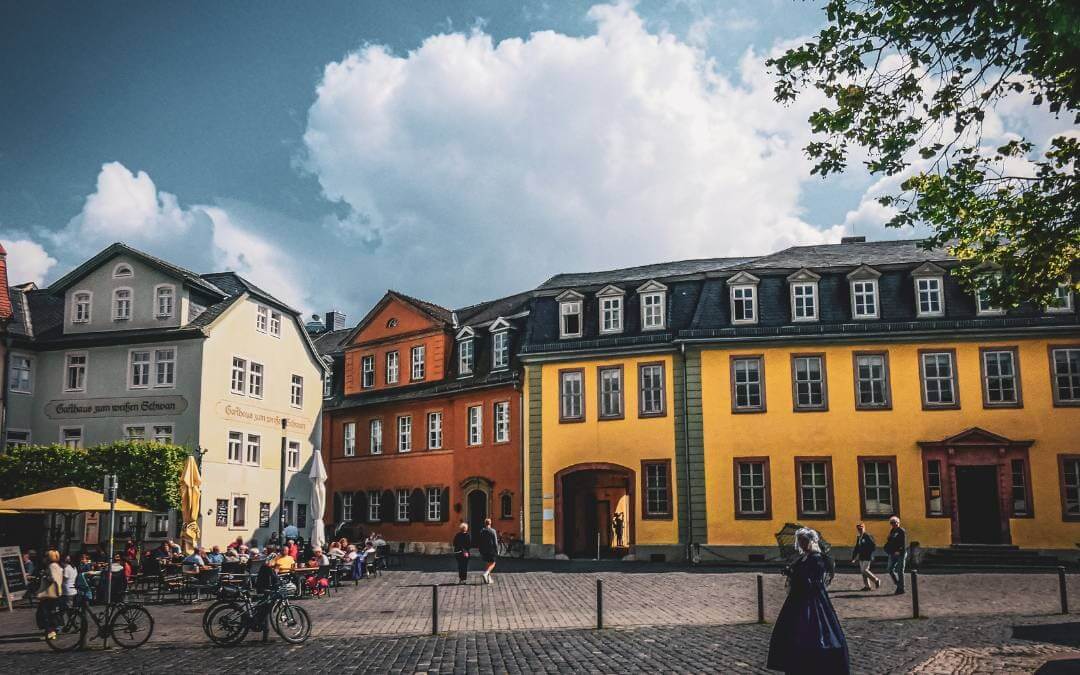
2. Buchenwald Memorial
In Weimar, the light and darkness of German history are close together. On the Ettersberg, just outside Weimar, the Nazis built the largest concentration camp on German soil - Buchenwald. On a guided tour of the Buchenwald Memorial you will learn the key data: 277,800 prisoners, of whom 30,000 were minors, 28,230 women, 249,570 men, from over 50 countries, 56,000 dead, age of prisoners: 2 to 86 years ...
The expert guides impressively describe what took place behind the fence - right next to a recreational area set up by the SS - before the eyes of Weimar residents.
The road from Weimar to Buchenwald leads over a concrete road that the prisoners, brutally driven by the SS, had to build themselves. They called it "Blood Road" - and that's the name of the road to this day.

the hour of the liberation of the camp on April 11, 1945.
The Buchenwald Gate
Above the entrance to the camp, the clock reads 3:15 p.m. - the hour of liberation on April 11, 1945. On the wrought-iron entrance gate is the cynical phrase "To each his own," which can only be read from the inside. Franz Ehrlich, a former Bauhaus student who was imprisoned as a communist in Buchenwald, had to design the letters for the gate in 1938. The fact that he used the Bauhaus typeface for this was his way of protest - the camp commandant didn't notice.
After the war, the Soviets established Special Camp No. 2 on the site of the former concentration camp. For example, NSDAP members, German spies, operators of illegal broadcasting stations, but also journalists and young people were interned. The camp was dissolved in 1950. Since 1990, the Buchenwald Memorial Foundation has also been working on this part of the camp's history, which was a taboo during the GDR era.
The Buchenwald Memorial
The huge Buchenwald Memorial Bell Tower near the former concentration camp is visible from many places in and around Weimar. It was built until 1958 as a national monument of the GDR on the burial place of thousands of concentration camp prisoners. The figures of the world famous Fritz Cremer bronze sculpture overlook the Weimarer Land and commemorate the resistance fight in the camp, which led to the liberation of the 21,000 detainees on April 11, 1945, even before the arrival of the American soldiers. The memorial bell, weighing almost 7 tons, is struck every hour.
What happens at the Crime scene Buchenwald cannot be summarized in a blog post. The concentration camp is a part of the history of this town that every visitor should come to terms with. You can find detailed information on the history of Buchenwald on the website of the Buchenwald Memorial,.
3. Bauhaus Museum
In addition to the sites of Classical Weimar, Weimar has another UNESCO World Heritage Site to offer: the Bauhaus.
You can experience the historical developments and spirit of the Bauhaus at the new Bauhaus Museum Weimar, which opened in 2019. The modern building houses an impressive collection of artworks, furniture, textiles, and architectural models that represent the groundbreaking work of Bauhaus artists and designers. Among other things, in this great museum you'll see design classics such as Peter Keler's Bauhaus cradle, the Wagenfeld table lamp, the Thonet cantilever chairs and the Barcelona armchair by Ludwig Mies van der Rohe.
Bauhaus in Weimar
The director of the Grand Ducal Saxon School of Arts and Crafts, the Belgian Henry van de Velde, left Weimar in 1917 during the First World War because he was harassed by the police and authorities as a so-called "enemy alien". He wished Walter Gropius as successor.
Gropius then founded the Bauhaus in Weimar in 1919, THE style-defining art school of the 20th century. One of the basic ideas of the Bauhaus was to combine architecture with the other arts and crafts. Gropius brought such important artists as Wassily Kandinsky, Paul Klee, Lyonel Feininger, Oskar Schlemmer and Gerhard Marcks to Weimar.
After the right-wing parties won the Thuringian state elections in 1924, they cut off the Bauhaus's funding. Gropius then moved the art school to the social democratic town of Dessau (Saxony-Anhalt). When the NSDAP won the municipal elections here in 1931, the Bauhaus moved to Berlin, where it was finally closed by the Nazis in 1933.
In Weimar, the main building of the Bauhaus University and the former School of Applied Arts,both designed by Henry van de Velde, and the Haus am Horn (designed in 1923 by Georg Muche as a show house - can be visited in the Park on the Ilm) belong to the UNESCO World Heritage Site "Bauhaus and its sites in Weimar, Dessau and Bernau"..
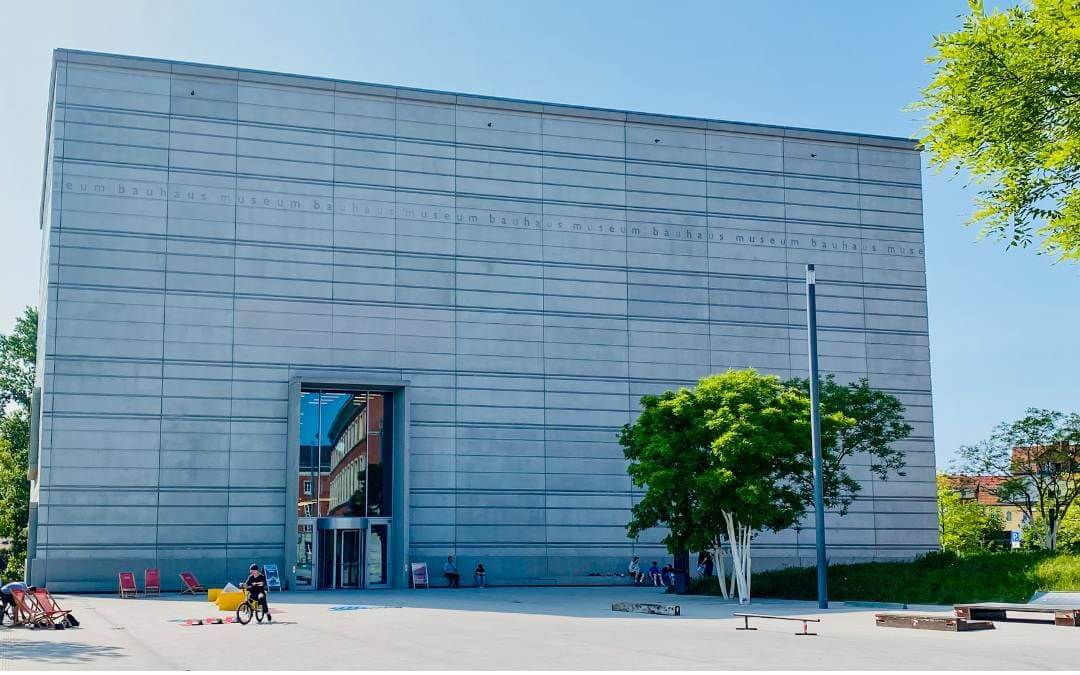
4. Rococo Hall of Duchess Anna Amalia Library
The rococo hall of the Duchess Anna Amalia Library is not only a place steeped in history, but also a real feast for the eyes that you should not miss. It represents classical Weimar in a magnificent way. There is hardly any other place where you can get closer to the four stars of Weimar Classicism - Goethe, Schiller, Wieland and Herder - than in the oval, two-story centerpiece of the library.
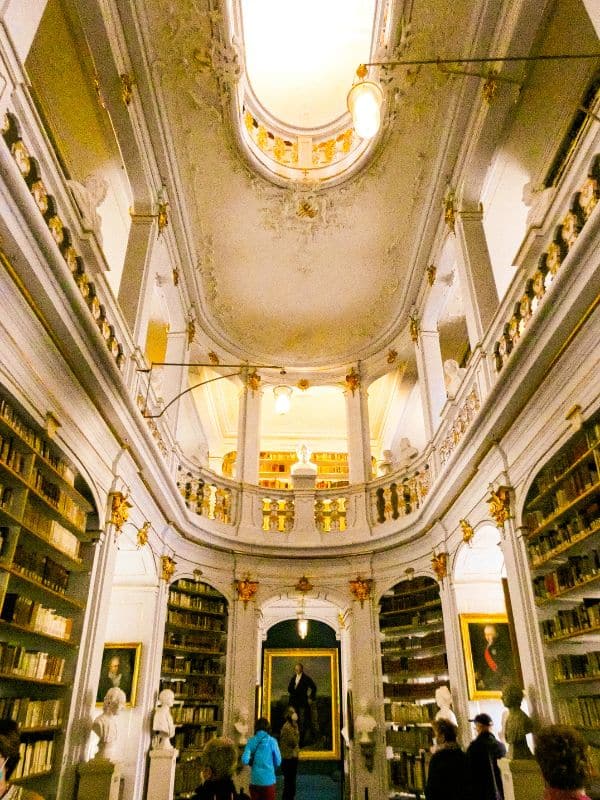
first visit to Weimar is a must. (With the support of the Klassik Stiftung Weimar)
Who was Anna Amalia?
The name donor Duchess Anna Amalia of Saxe-Weimar and Eisenach, née Princess of Brunswick-Wolfenbüttel, was the mother of Goethe's friend Carl August I. After the early death of her husband Ernst August II (1737 - 1758), she took over the affairs of state until her eldest son was of age.
Anna Amalia was an emancipated, educated and musically very gifted woman who snorted tobacco and loved playing cards (which was also fashionable among women at the time). She brought the poets Wieland and Knebel to the Weimar court to educate her sons. She was thus an important pioneer of Weimar Classicism.
The Library in the Green Palace
Founded in 1692 by Duke Wilhelm Ernst, the ducal library was bursting at the seams with 30,000 volumes in 1766. Anna Amalia therefore moved it to the Green Palace in the park on the Ilm River. Duke Carl August appointed Goethe as head librarian in 1797. Together with Christian Gottlob Voigt, Goethe reformed and expanded the library. When he died, the collection already comprised some 80,000 books. At the end of the 20th century, the library in the Green Palace was expanded to include the Red and Yellow Palaces on the opposite side of Platz der Demokratie (Democracy Square). A study center was established in the inner courtyard of the old building ensemble in a new cube-shaped building.
The Herzogin Anna Amalia Library is an archive and research library. The books can be read and explored in the reading room and in the digital collections. 40,000 volumes are in the Rococo Hall, and more than a million in the stacks under Platz der Demokratie. Tens of thousands of books and digital media are added annually.
The Fire in Duchess Anna Amalia Library
Perhaps you too can remember the catastrophic fire in which 50,000 of the valuable books were lost forever. On the evening of September 2, 2004, a fire broke out in the library's attic - probably caused by a defective electrical cable. Of 25,000 books - the so-called "ash books" - only fragments remained. But 118,000 volumes were recovered in a spectacular rescue operation. Fire departments from all over the surrounding area were involved, and hundreds of Weimar citizens formed human chains to rescue busts, paintings and books. Twenty-seven workshops across Europe were involved in the restoration of the bindings.
As there was no standardized method for treating fire damage to books in such large quantities in 2004, the Duchess Anna Amalia Library set up Germany's only restoration workshop for fire-damaged written material in Weimar in 2008 with the help of the Vodafone Foundation Germany. Since then, around 60,000 pages of damaged books have been restored here using a standardized process. With the help of the Volkswagen Foundation, some of the ash books have been digitized.
The library was able to reopen in 2007 only three years after the fire.
5. Schiller's Residence
Schiller's residence is one of the most important sights in Weimar, especially for literature lovers. It is located just a few steps away from Goethe's house on Frauenplan. The two poets visited each other frequently to discuss and collaborate. But they also wrote a lot of letters to each other (Goethe himself published the correspondence with Schiller,which he called his greatest treasure, in 1828/29). Schiller lived in this house with his wife Charlotte and their four children from 1802 until his death in 1805 at the age of only 45.
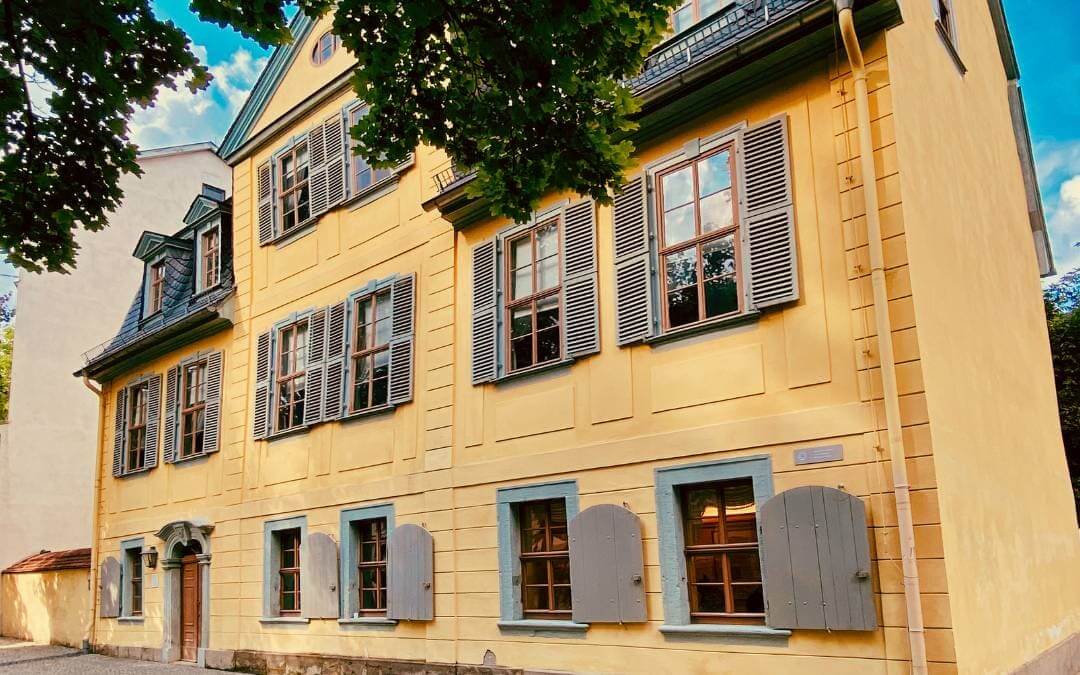
The house has been lovingly restored and authentically shows how the poet once lived and worked there. In the rooms you will find personal objects, furniture and writings that give you a direct impression of Schiller's everyday life. It is as if time has stood still and you can come face to face with Schiller himself. In Schiller's study, you can see his original desk where he wrote "The Bride of Messina" and "William Tell", with some original objects such as inkwells and paperweights.
How did Schiller come to Weimar?
Friedrich Schiller was born in 1759 in the Swabian town of Marbach am Neckar and studied at the Karlsschule in Stuttgart first law, later medicine, in which he earned his doctorate in 1780. His passion, however, was writing. His first drama, "The Robbers," premiered in Mannheim in 1782 and made him famous overnight. For the premiere, he - by now a military doctor - had left Stuttgart without permission, which so annoyed the Württemberg sovereign Duke Carl Eugene that he banned Schiller from writing after another unauthorized visit to the theater.
His flight took Schiller to Thuringia for the first time. The years from 1783 to 1789 were precarious for him, despite his success as an author. Constantly in search of patrons who would finance his livelihood as one of the first "professional writers," he frequently changed his place of residence. Although his first meeting with Goethe in Rudolstadt in 1788 was rather underwhelming, the latter helped him to obtain a professorship in Jena - initially without a salary. Schiller was so popular with young people that the rush of students at his inaugural lecture exceeded the capacity of the lecture hall. From 1790 Schiller received a salary from the Weimar Duke Carl August, which improved his financial situation. However, Schiller did not finally move to Weimar until 1799. He bought the house on the Esplanade, which is now called Schillerstrasse, in 1802.
In order to be able to keep the house after Schiller's death - because there was still a residual debt on it - his wife Charlotte rented out the rooms in the attic.
Schiller's residence became the first literature museum in the German-speaking world,after the city of Weimar bought the house in 1847.
6. Park on the Ilm with Goethe's Gartenhaus
A highlight for any visitor to Weimar is the beautiful park on the Ilm River (also called Ilmpark), which is closely associated with Goethe's life and work. Duke Carl August I of Saxony-Weimar-Eisenach, with whom Goethe was a close friend, gave the poet a former vineyard house with a garden.Goethe lived there for seven years until he moved to the Frauenplan.
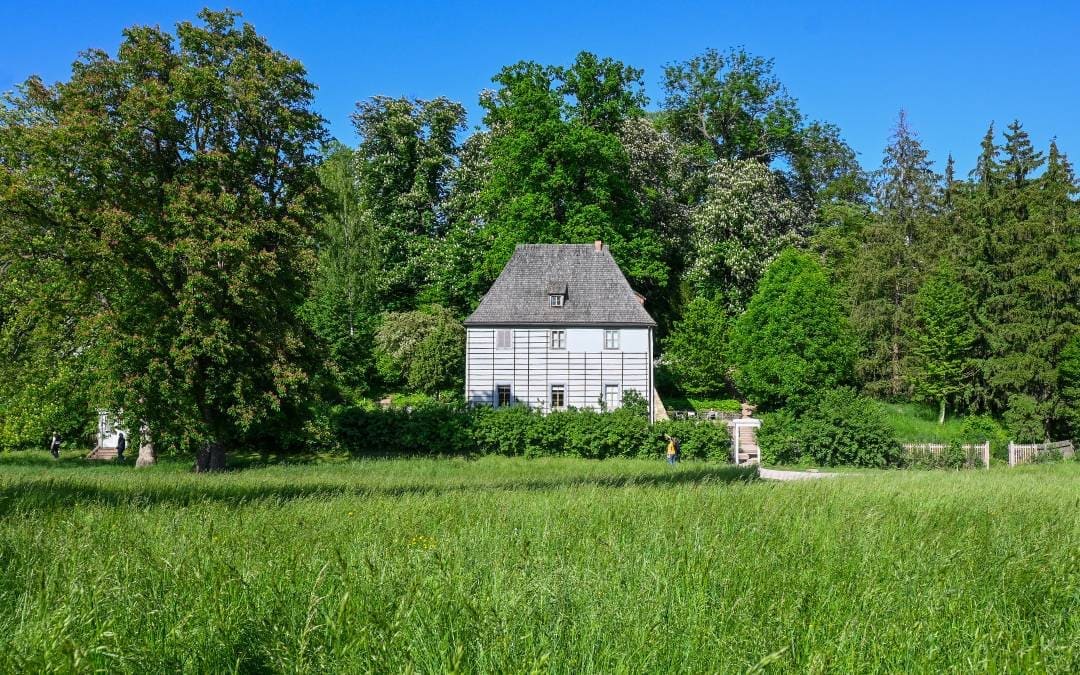
Inspired by English landscape gardens and the Wörlitz Park near Dessau, the duke and Goethe began to gradually lay out the park on the Ilm in 1778, incorporating three older ducal gardens. The park was not surrounded by a fence or a wall and was thus freely accessible to all citizens of the city. It is one of the best preserved parks of the Romantic period in Germany, with an almost unchanged, partly exotic tree population, sight lines, grottos, artificial ruins and bridges.
In the Gartenhaus you can see original furniture such as Goethe's standing desk and seat and imagine how he looked out through the window of his bedroom to Charlotte von Stein's house while he was writing passionate verses.
Even in the early Weimar years, Goethe's own staff took care of the house, which was much more lavishly furnished than it is now. The poet put a lot of love into his garden. He laid out vegetable beds and flower borders, planted rose bushes, fruit trees and conifers.
In the garden you will also find a remarkable sculpture that Goethe himself designed together with his former Leipzig teacher Adam Friedrich Oeser - the Stone of Good Luck (also "Altar of Agathe Tyche"). The cuboid (symbol of stability and constancy) with the sphere placed on top (symbol of the capricious luck, instability and restlessness) was one of the first non-figurative monuments in Germany.
The garden house remained an important retreat for Goethe throughout his life. The house and garden have been preserved almost unchanged and became a place of pilgrimage for his fans soon after Goethe's death.
In addition to Goethe's Gartenhaus, there are a number of other attractions in Park an der Ilm. Here is a selection:
- Roman House: Carl August's summer residence, which he had built in the style of a temple at the suggestion of Goethe after his trip to Italy.
- Borkenhäuschen: In 1778, Goethe created a small hermitage with a cottage, the Luisenkloster, for Duchess Luise's name day. The hut was converted into the Borkenhäuschen in 1784 and served as a retreat for Duke Carl August until the completion of the Roman House in 1797.
- Franz Liszt Monument: Created in 1902 by Hermann Hahn in honor of Franz Liszt, who lived in Weimar from 1848 to 1861 and from 1868 until his death in 1886.
- Templar House: The remains of a ducal salon with a lookout tower built in 1821/23 and destroyed in 1945.
- Artificial ruin: It was in line with the taste of the time to build artificial ruins in English landscape gardens. This one looks like the remains of a medieval castle.
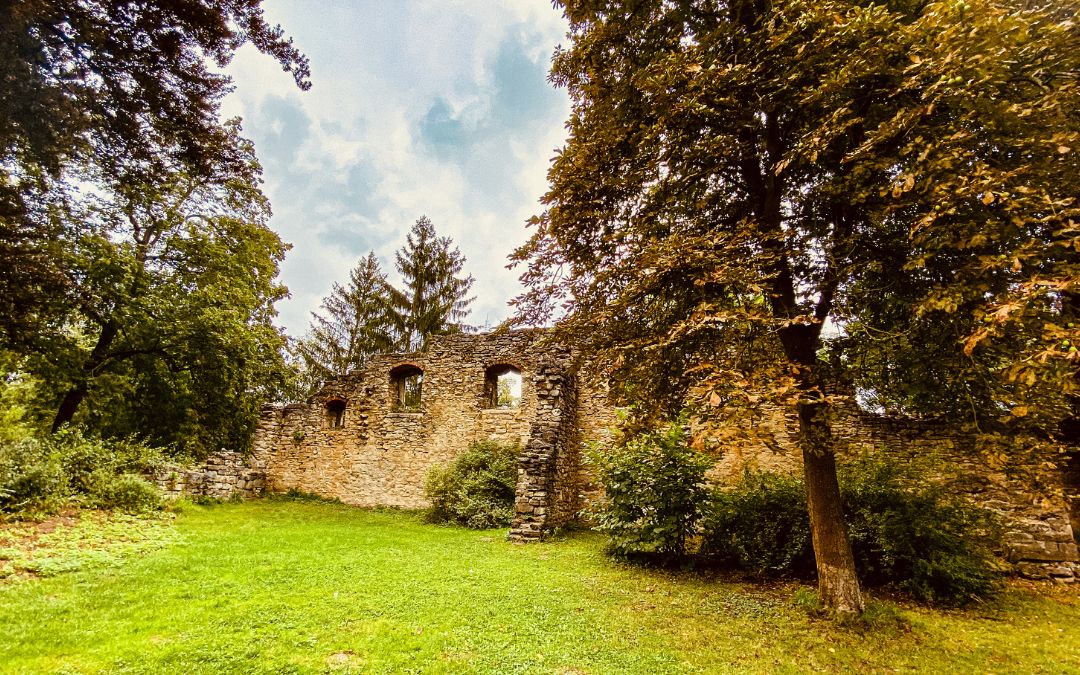
The Park on the Ilm with Goethe's Gartenhaus is part of the UNESCO World Heritage Site "Classical Weimar".
7. German National Theater and Goethe-Schiller Monument
The German National Theater is one of the most renowned theaters in Germany. From 1791 it was directed by Goethe, who premiered almost all of Schiller's dramas here.
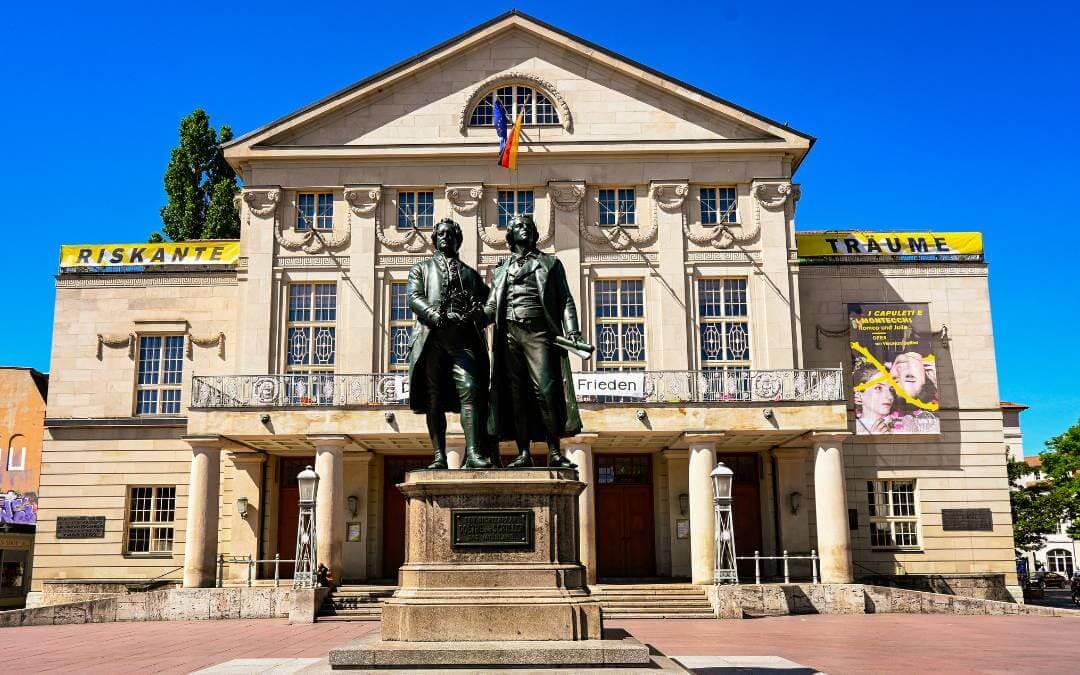
The friendship between Goethe and Schiller
In 1794, Schiller and Goethe met at the meeting of the Natural Research Society in Jena and discussed Goethe's theory of the primordial plant after the meeting. According to Goethe's notes, this event was the beginning of their legendary friendship. From then on, they wrote letters to each other, visited each other, and also worked closely together on their respective works.
After Schiller moved to Weimar in 1799, the two saw each other almost daily, often worked together late into the night, and were critical and inspiring interlocutors for each other in their literary work. Schiller's death from pneumonia in 1805 hit Goethe hard: "I thought I was losing myself, and now I am losing a friend and in him half of my existence," he wrote in a letter to Carl Friedrich Zelter.
The theater building is no longer the same as it was in the days of Weimar Classicism. When it no longer met the requirements, it was demolished in 1907 and replaced by a neoclassical building. At July 31, 1919 - shortly after the founding of the Weimar Republic - Germany's first democratic constitution was adopted in this theater.
Unfortunately, this historic moment was followed by a period of decline. In 1926, the theater of Goethe and Schiller hosted the first Reich Party Congress of the NSDAP and during the Second World War, the building was even used for an armaments factory. On February 9, 1945, during the bombing of Weimar by the Americans, it was reduced to rubble except for parts of the facade. For Goethe's 199th birthday, it was already reopened in 1948 as the first German theater with Faust I.
In front of the theater stands the double monument of Goethe and Schiller, probably one of the most famous German monuments. Although Goethe was only 1.69 m tall, the Dresden sculptor Ernst Rietschel made him equal in size to Schiller, who at 1.80 m was a tall man by the standards of the time. The bronze monument was unveiled on September 4, 1857, on the 100th birthday of Duke Carl August I of Saxe-Weimar and Eisenach. The bronze plate on the granite base bears the inscription "To the poet couple Goethe and Schiller. The Fatherland."
8. Historic Cemetery and Ducal Vault
Weimar's historic cemetery is one of the most beautiful and important in the whole of Germany. The focal point of the grounds, which were laid out in 1818, is the Prince's Crypt, which contains the coffins of the ducal family of Saxe-Weimar and Eisenach as well as those of Goethe and Schiller. Duke Carl August wanted to be close to his friend Goethe even in death and arranged for Goethe to be buried here. In the year of the Duke's death (1828), Mayor Schwabe, who still knew Schiller personally, had his supposed remains transferred to the Historical Cemetery, as Goethe again wished to be buried next to Schiller.
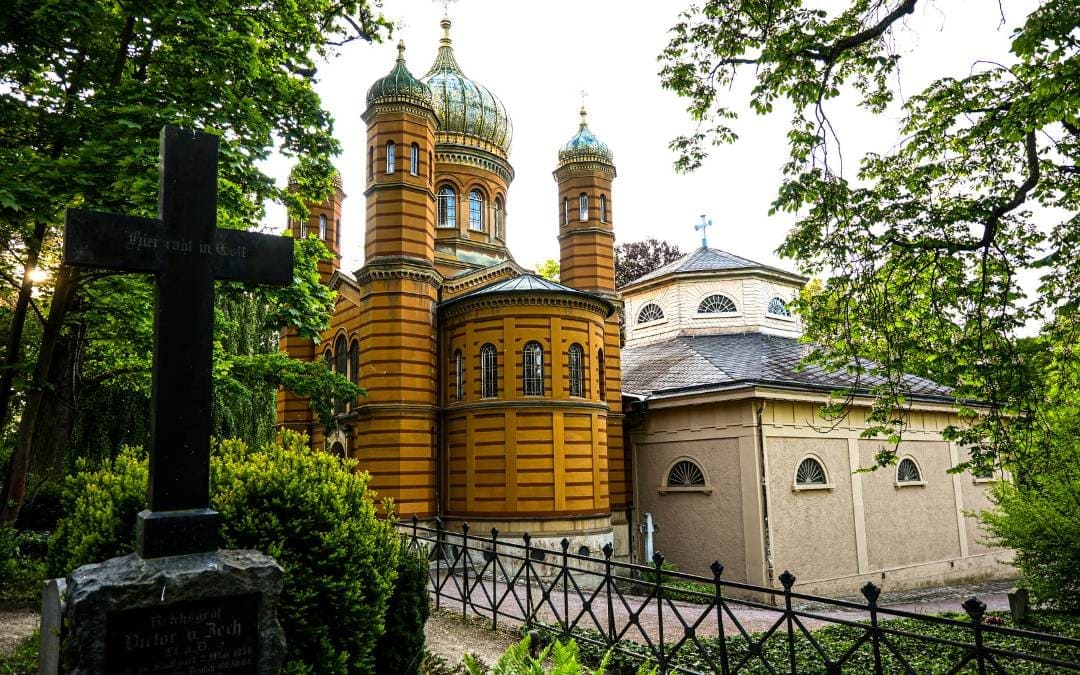
Like other deserving citizens of Weimar who did not have their own family burial place, Schiller was originally buried in the coffin vault of St. Jacob's Cemetery. As this was a collective grave, it was repeatedly suspected that the remains in Schiller's coffin were possibly not Schiller's at all. In 2008, the Schiller code was cracked as part of an international scientific project and it turned out that there was no Schiller in Schiller's coffin. The Klassik-Stiftung then decided to stop searching for Schiller's bones. Since then, the coffin next to Goethe, which bears Schiller's name, has been empty.
Not far from the Ducal Vault you will find the graves of the Goethe family, Goethe's muse Charlotte von Stein,and Goethe's friend Johann Peter Eckermann. Also worth seeing is the Monument to the March Fallen by Walter Gropius in the southern part of the cemetery.
The beautiful Russian Orthodox chapel adjacent to the Ducal Vault is the burial place of Maria Pavlovna's, a daughter of the Russian Tsar Paul I, who was married to the son of Goethe's friend Carl August. She was buried here in Russian soil and according to her Orthodox faith.
The Ducal Vault and the Historic Cemetery are part of the UNESCO World Heritage Site Classical Weimar.
9. Belvedere Palace and Park
In and around Weimar you can discover many palaces. The most beautiful one is Belvedere Palace, the former baroque summer residence of the ducal family of Saxe-Weimar and Eisenach. Especially Duchess Anna Amalia and Grand Duchess Maria Pavlovna (the Russian tsar's daughter was married to Grand Duke Carl Friedrich - the son of Goethe's friend Carl August) liked to retreat here. In the gardens of the palace you can discover hidden places, artificial ruins and sculptures. From the hill on which the palace was built, you have a magnificent view of Weimar - as the name "Belvedere" (beautiful view) promises.

At the beginning of the Renaissance, the city palaces became too cramped for the nobility and they began to build pleasure palaces in extensive parks. Dances, concerts and hunts were organized for entertainment. Belvedere Palace was built from 1724 by Duke Ernst August as a replica of Belvedere Palace in Vienna, and since it is located on a hill with a panoramic view, he did not even have to change the name.
Particularly worth seeing is the Russian Garden, a copy of the private garden of the tsar's family in St. Petersburg. Grand Duke Carl Friedrich wanted his wife Maria Pavlovna to feel at home in Weimar. Therefore, seven years after her wedding, he gave her this little piece of Russia to remind her of the gardens in St. Petersburg, where she had spent much of her childhood. The left part of the garden is called Cupid's Garden because there is a small sculpture depicting Cupid feeding a nightingale.
Since 1923, the palace has housed a museum of 18th-century arts and crafts, displaying exquisite porcelain owned by the ducal family of Weimar.
The Orangery was set up by Duke Carl August, who spent a lot of money on exotic plants. Together with Goethe, he conducted botanical experiments at Belvedere Palace.
10. Herder Church (City Church of St. Peter and Paul)
The church of St. Peter and Paul is known in Weimar as the "Herderkirche" (Herder Church). In 1787, through Goethe's mediation, Duke Carl August appointed the theologian and philosopher Johann Gottfried Herder general superintendent of the Weimar city church (the counterpart to the court chapel, which was reserved for the nobility). Here, Schiller and Goethe listened to Herder's unconventional sermons. A cast-iron slab with Herder's motto "Light, Life, Love" covers his tomb in the central nave.

The first church was built from 1245 to 1249, but was destroyed in a fire in 1299, the second building was severely damaged in the town fire in 1424. The present building dates back to a hall church in late Gothic style, built between 1498 and 1500. The most famous musician who worked here was Johann Sebastian Bach,who lived in Weimar from 1707 to 1718.
In 1945, the church was severely damaged during air raids. For the reconstruction, which lasted until 1953, Nobel Prize winner for Literature Thomas Mann, donated the prize money of the Goethe National Prize, which he had received in Weimar in 1949. In the fall of 1989, the Herderkirche was an important assembly place of the peaceful revolution. Together with the Herder House and Garden and the neighboring Old Grammar School, the church is part of the ensemble "Classical Weimar", which was listed as UNESCO World Heritage Site, in 1998.
The main attraction of the Herder Church is the three-winged altar. According to recent research, the altarpiece "Christ on the Cross" was created by Lucas Cranach the Younger between 1552 and 1555 and not, as long assumed, by his father Lucas Cranach the Elder in the year of his death. It is now considered the major work of Saxon-Thuringian art of the 16th century. Another important work in the church is the so-called Luther shrine by Veit Thiem, a tryptichon with portraits of Martin Luther, who preached in the church several times.
11. Market Square Weimar - Highlights
In any case, you must also pay a visit to the market square, which is the colorful and bustling center of the city on market days. It is framed by a number of historical buildings that are closely connected with Weimar's history.

If you look closely, you can see the Meissen porcelain bells in the tower.
Court Pharmacy
The buildings on the north side of the market square were all destroyed during the Second World War. They were reconstructed only from 1988 to 1994. The Renaissance oriel and the portal of the Court Pharmacy were preserved and integrated into the new building. It was here that Goethe obtained ointments and Carlsbad salt - a common laxative at the time.
Townhouse
At the eastern corner of the market square is the tourist information office in an imposing town house, which also fell victim to the hail of bombs, but was rebuilt soon after the war.
Cranach House
Right next to it is the Cranach House, one of the most beautiful Renaissance buildings in Thuringia, a semi-detached house built between 1547 and 1549 according to plans by Nikolaus Gromann - one of the most important master builders of his time. Lucas Cranach the Elder spent the last year of his life in the left half of the house - still full of creative energy despite his age of 80. Cranach's daughter lived in the right half of the house with her husband, the ducal chancellor Christian Brück, who had commissioned the house. From 1732, the building housed Weimar's oldest bookstore, whose customers included Goethe, Schiller, Herder and Duchess Anna Amalia. Today the building houses the "Theater im Gewölbe".
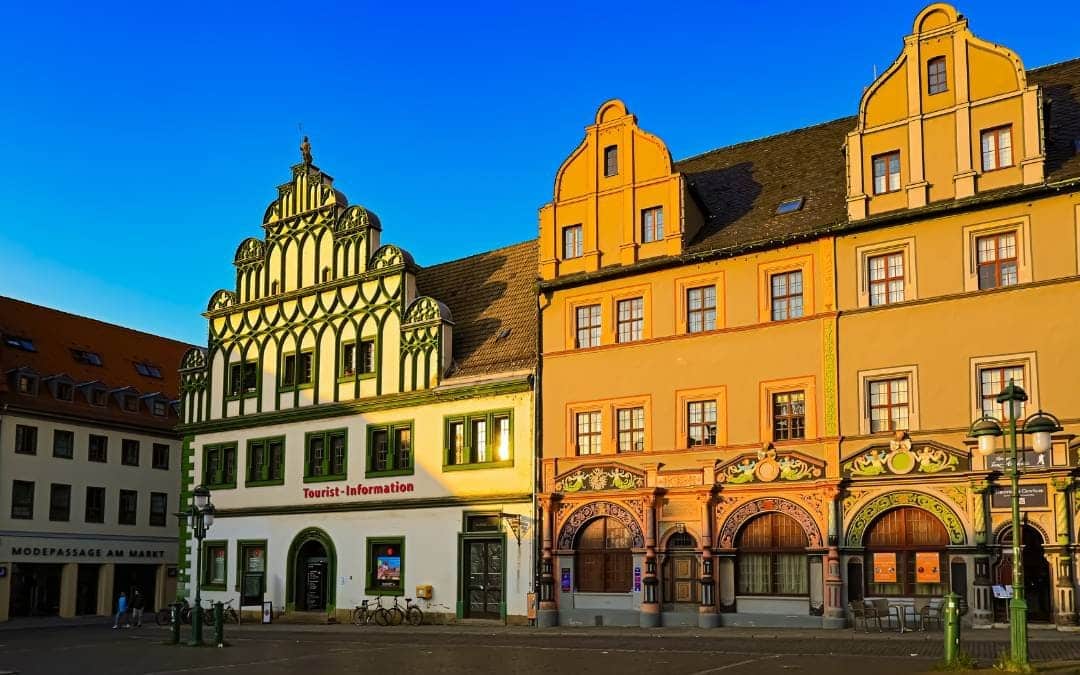
Hotel Elephant
On the south side of the market square stands a hotel with a world reputation, in which Goethe already accommodated his guests - Hotel Elephant. It has hosted numerous famous (and infamous) personalities, including Felix Mendelsohn-Bartholdy, Leo Tolstoy, Richard Wagner, Helmut Kohl, Mikhail Gorbachev and Vladimir Putin. Hitler had the citizens of Weimar cheer him on the balcony of his room during his numerous stays in Weimar. He had the previous building, which he considered not representative enough for him, replaced by the current one in 1938. The first guest in the suite with the balcony after the reopening in 1955 was the Nobel Prize winner for literature Thomas Mann,who, as a fierce opponent of National Socialism, had emigrated to the USA in 1938.
City Hall,
The most striking building on the market square is probably the neo-Gothic City Hall, From 1841. During my first visit to Weimar in 2021, the town hall, which had been renovated for years, was still completely covered in scaffolding. This time (in May 2023) I was lucky and could admire the town hall and market square in all their glory. The town hall bell was melted down for armament purposes during World War II. Since 1987, a carillon made of Meissen porcelain has sounded from the town hall tower several times a day, playing seasonally appropriate songs. From the beginning of January to the end of March, the bells have a winter break.
Neptune Fountain
The most popular photo motif on the market square is the Neptune Fountain, the oldest fountain in the city, which was built in 1545 as the Lion Fountain. The lion is Weimar's heraldic animal and had to give way to Neptune, popular during the Renaissance, in 1774.
Weimar's market square reflects Weimar's eventful history and is an essential part of a visit to the city. It's best to stop by on a market day in the morning and if possible also in the evening to experience the completely different atmosphere - colorful and bustling in the morning, quiet and contemplative in the evening.
12. City Palace
The predecessor of today's city palace was a wooden medieval moated castle. From the mid-16th century until the devastating castle fire in May 1774, it was the residence of the Dukes of Saxe-Weimar and Eisenach. The fire made the castle uninhabitable and Duchess Anna Amalia moved into the Wittumspalais. It was not until 15 years later that Duke Carl August began the reconstruction and appointed Goethe as chairman of the palace building commission. The reconstruction dragged on and it was not until 1803 that Carl August and his family moved into the east wing of the palace. Highlights of the classicist interior from this construction phase are the staircase and the ballroom.
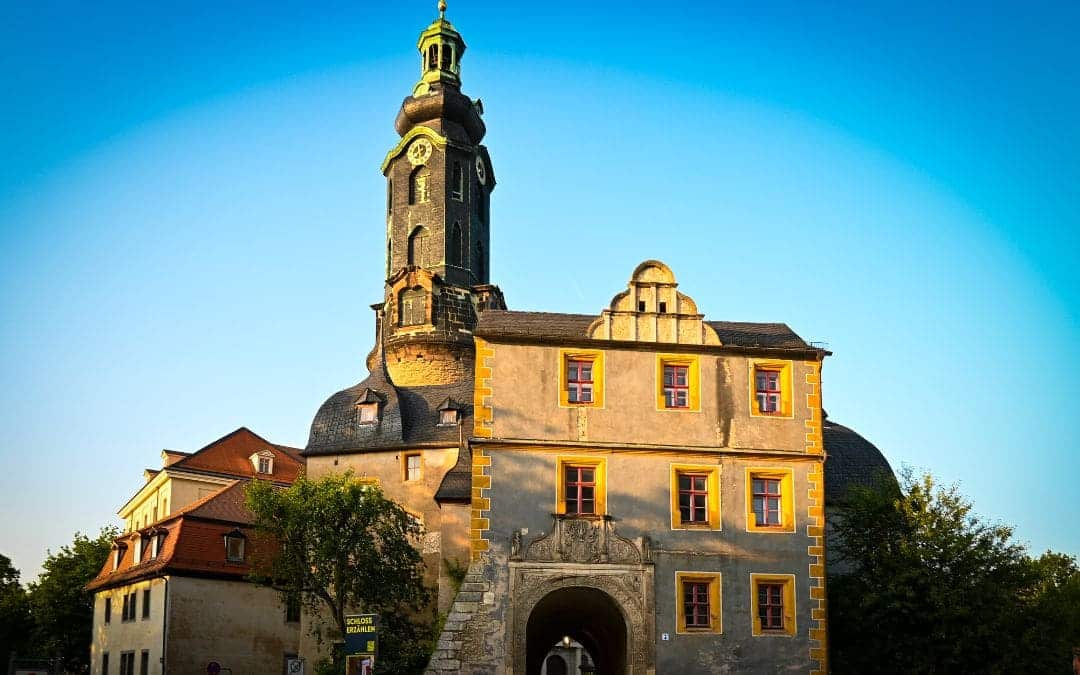
Just in time for the arrival of Maria Pavlovna, a daughter of Russian Czar Paul I, whom Carl August's son Carl Friedrich married in Saint Petersburg in 1804, the west wing was completed. It was important for the small duchy of Weimar that Maria, who came from one of the most powerful and wealthy families in Europe, could move into rooms befitting her status. After the death of her father-in-law Carl August in 1828, Maria Pavlovna followed in the footsteps of Anna Amalia and became a great patron of the arts at the Weimar court.
The west wing of the city palace was built from 1816 onwards by the new chief building director Clemens Wenceslaus Coudray, who has a significant share in today's classicist townscape of Weimar. Between 1835 and 1847 Maria Pavlovna had the so-called Poets Rooms installed in honor of Goethe, Schiller, Herder and Wieland. These memorial rooms are a synthesis of the arts, the design of which involved artists such as Karl Friedrich Schinkel, Clemens Wenceslaus Coudray and Frederick Preller the Elder. participated. Now, after extensive renovation, they can be visited again as part of a guided tour. I took such a tour at the end of May 2023 and was thrilled! In the really amazing murals scenes from the poets' works are depicted.
The restoration of the Poets' Rooms was part of the overall renovation of the Weimar City Palace, which will take several more years.

13. Wittumspalais
The Wittumspalais was Anna Amalia's residence after her eldest son Carl August took over the reins of government from her when he came of age. Since the city palace was not an option due to the great fire of 1774, she looked for a new place to live and found the residence of the minister Freiherr Jakob Friedrich von Fritsch suitable, who gave it to her for the amount of 20,100 reichstalers (which would probably correspond to several million euros today).
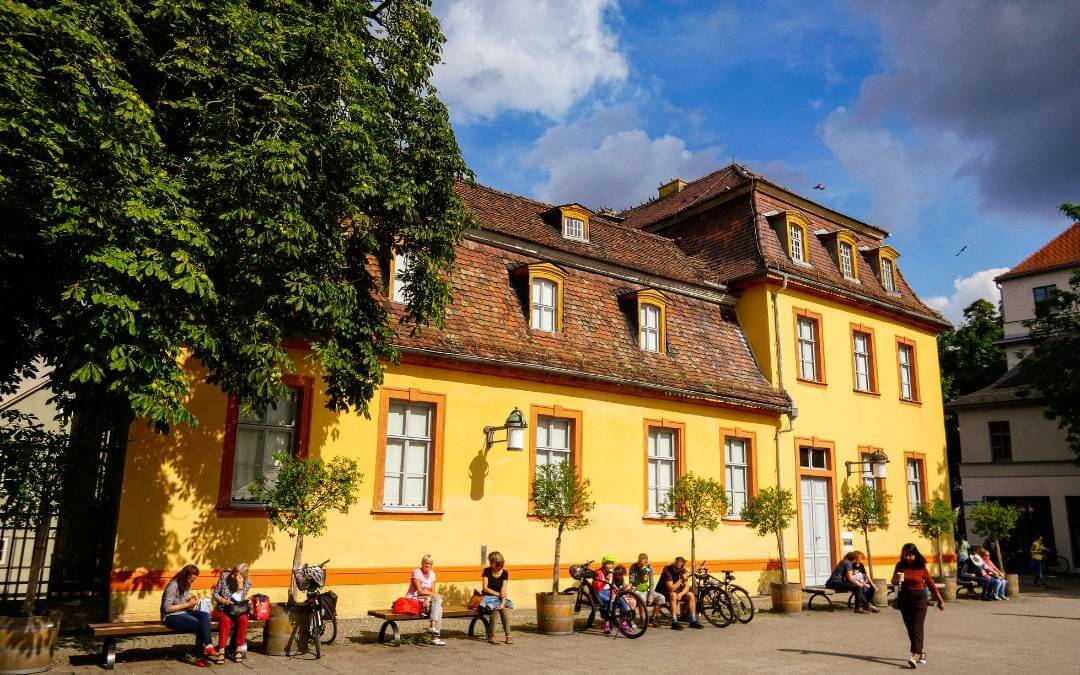
The house in which the duchess lived for 33 years gives you a unique, authentic insight into the ducal living culture of the 18th century. The duchess devoted herself to her many interests here; she composed, made music, painted and drew. In the Tafelrundenzimmer, Anna Amalia regularly received artists and scholars for social gatherings and to discuss a wide variety of topics.
During the tour of the palace, you will see the duchess' private and social rooms. Highlights include the Tafelrundenzimmer (Round Table Room), the ceiling painting in the banquet hall by Adam Friedrich Oeser, and the Grüner Salon (Green Salon), Anna Amalia's living room, most of which is originally furnished.
14. Liszt House
After years as a restless "traveling virtuoso," the brilliant pianist and composer Franz Liszt settled in Weimar in 1848 with his new life companion, the already married Carolyne Princess of Sayn-Wittgenstein.Liszt had recently been appointed Kapellmeister by Grand Duke Carl Friedrich. Initially, the couple lived with Carolyne's daughter 12 years in the Altenburg on the outskirts of Weimar. After the planned marriage of the two (the pope had in the meantime approved Carolyne's divorce) in Rome failed, Liszt initially withdrew to a monastery, but then resumed his former vagabond life, which, however, did not harm his enormous productivity.
In 1869, Liszt followed the call of Grand Duke Carl Alexander and settled once again in Weimar, where he moved into an apartment in the former court gardener's house, which he occupied until his death in 1886. Here he taught young, talented pianists from Germany and abroad. Liszt's living quarters can be visited today in the Liszt House. His music salon and study, including the Bechstein grand piano, have been preserved in their original form.
Liszt's gravesite, by the way, is not in Weimar but in Bayreuth, where he died of pneumonia during a visit to the Bayreuth Festival.
Not far from the Liszt House a monument in the Park on the Ilm, created by Hermann Hahn in 1902, commemorates the great composer.

15. Nietzsche Archive
Another highly interesting sight of Weimar is villa "Silberblick". Here the philosopher Friedrich Nietzsche spent the last years of his life in mental derangement. He was cared for by his sister Elisabeth Förster-Nietzsche, who had been married to the radical anti-semite Bernhard Förster. The latter had founded the settlement Nueva Germania in Paraguay, a kind of refuge for the Aryan race 🤦♀️.
Nietzsche died in this house on August 25, 1900. Förster-Nietzsche had the villa redesigned by Henry van de Velde after her brother died. Already after her mother's death in 1895, she had succeeded in taking control of Nietzsche's work. The manuscripts, letters and other documents of her brother, which she had collected, were archived here by competent employees - such as Rudolf Steiner, who had already worked in the Goethe archive, and Nietzsche's assistant Heinrich Köselitz, who was the only one who could decipher Nietzsche's handwriting. None of the employees, however, had access to the entire archive, so that Förster-Nietzsche's forgeries were not discovered until long after her death in 1935.
You can visit the private rooms, which have been completely preserved, including the furnishings. The exhibition in the former dining room focuses on the Nietzsche cult in National Socialism, which was promoted by Elisabeth Förster-Nietzsche. Hitler visited Förster-Nietzsche several times in the Nietzsche Archive between 1932 and 1934, and she even gave him her brother's walking stick.
Nietzsche's original manuscripts are today in the Goethe and Schiller Archive in Weimar.
16. St. James Church and St. James Churchyard
St. James Church (Jakobskirche) was originally built in 1168 as a pilgrimage church on the way to Santiago de Compostela. Due to dilapidation, Duke Wilhelm Ernst had the old church demolished in 1712 and a new single-nave Baroque church built from 1712 to 1714. The new St. James Church even became the court church after the fire in Weimar Castle in 1774. St. James Church looks surprisingly bright and friendly inside.
On October 19, 1806, Goethe finally married Christiane Vulpius in St. James Church after having lived with her for 18 years already. Because a hospital for the wounded soldiers of the Battle of Jena-Auerstedt was set up in the church's nave at the time, the wedding ceremony had to take place in the sacristy behind the altar. Today's pulpit altar, however, is no longer the same as at Goethe's wedding, but was consecrated in 1817 in the course of a classicist reconstruction.
St. James Churchyard is the oldest cemetery of the city with 54 very old memorial plaques and graves. Also Lucas Cranach the Elder is buried here. Christiane von Goethe's grave was long lost. In 1888 it was rediscovered and the Goethe Society provided it with the grave slab bearing Goethe's farewell verses for his wife:
You seek, o sun, in vain
To shine through the dark clouds!
The whole gain of my life
Is to lament her loss.
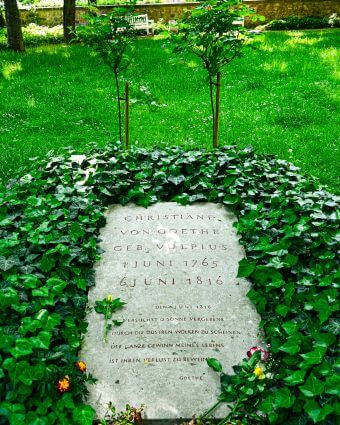
Friedrich Schiller was buried in the vault of the Jakobskirchhof at the time. However, since the crypt was no longer used after 1823, it became visibly dilapidated. You can read the grotesque story about Schiller's bones above in the paragraph about the Ducal Vault .
Over a partly narrow and steep staircase you can reach the St. James Church Tower and from up there enjoy a wide view over Weimar and its surroundings. This is unfortunately somewhat marred by the uncleaned windows, which could not be opened during my visit. Nevertheless, I found that the climb was worth it.
Other Points of Interest in and around Weimar
Weimar has an incredible number of important museums and cultural treasures, which I cannot present here in detail. Depending on your interests, one or the other of the following museums could be interesting for you:
Sights within Weimar:
- Museum New Weimar: The art museum, which was destroyed during World War II, was only reopened in the Capital of Culture year 1999. The permanent exhibition "Van de Velde, Nietzsche and Modernism around 1900" presents important works of realism, impressionism and art nouveau, among others by Monet and Rodin.
- House of the Weimar Republic (HDWR): When the Bauhaus Museum moved into the new building in 2019, the Forum for Democracy was set up here - opposite the German National Theater - to mark the 100th anniversary of the founding of the Weimar Republic with a permanent exhibition with a modern design.
- Haus am Horn: The first Bauhaus model house was designed by Georg Muche in 1923. The house can be visited. It is located above the park on the Ilm River, near Goethe's garden house.
- Haus Hohe Pappeln: Grand Duke Wilhelm Ernst brought the Belgian star architect Henry van de Velde to Weimar in 1902 as head of the School of Arts and Crafts. Haus Hohe Pappeln is Van de Velde's former residence, which he had built in 1907/1908 according to his own plans.
- Kirms-Krackow House: The Kirms family house was an important meeting place for artists and scholars in classical and post-classical Weimar. Famous house guests included the composers Liszt and Hummel, the poet Hans Christian Andersen and the playwright Iffland. Today, the building houses an exhibition on bourgeois residential culture in the 18th and 19th centuries.
- Museum of Prehistory and Early History of Thuringia: The informative museum on the cultural history of Thuringia since the Stone Age offers more than 3,000 impressive exhibits, including bone finds of the Bilzingsleben Homo erectus.
Sights outside Weimar:
- Tiefurt Castle and Park: The small country palace on the Ilm was the summer residence of Duchess Anna Amalia from 1781, who hosted Goethe, Schiller, Wieland, Herder and other illustrious guests here. The 21-hectare Tiefurt Landscape Park belongs to the castle.
- Ettersburg Castle and Park: Ettersburg Castle was Duchess Anna Amalia's summer residence before she moved it to Tiefurt. Friedrich Schiller completed his work "Maria Stuart" here in 1800. In the mid-19th century, Ettersburg experienced a revival under Grand Duke Carl Alexander, who invited such dazzling figures as Franz Liszt and Hans Christian Andersen to Ettersburg.
- Wielandgut Oßmannstedt: The poet and translator Christoph Martin Wieland lived in the manor house 10 km north of Weimar from 1797 to 1803, and his grave is located in the manor park. The baroque manor house is partly equipped with original interior.
- Kochberg Castle, Park and Liebhabertheater: The manor about 30 km south of Weimar belonged to the von Stein family since 1733. Goethe's muse Charlotte von Stein spent a lot of time there, and Goethe often visited her there. The Liebhabertheater was built in 1800 by Carl von Stein. Theaters, concerts and author readings have been held here again in the summer since 1975.
- The beautiful state capital of Thuringia is well worth a visit Erfurt is only 12 minutes by train from Weimar. The Jewish-medieval heritage of Erfurt is Germany's newest UNESCO World Heritage Site.
The Most Important Questions about Your Trip to Weimar
Is Weimar a beautiful city?

Weimar is beautiful and one of my favorite cities in Germany. The atmosphere shaped by the Weimar Classicism, which is also reflected in the many baroque buildings, is unique. In addition, you can always find a green and also quiet place to stay. Weimar is a place for culture fans and connoisseurs!
What should I not miss in Weimar?
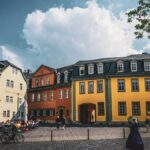
In my opinion, you should not leave Weimar without visiting at least two museums: Goethe's residence at the Frauenplan and the Rococo Hall of the Duchess Anna Amalia Library. The park on the Ilm with Goethe's garden house is also a must and a green oasis to boot! For architecture and design lovers a visit to the Bauhaus Museum is absolutely a highlight. To get a complete picture of Weimar and its history, I definitely recommend also visiting the former concentration camp Buchenwald, .
What are the festivals and events in Weimar?

Thuringian Bach Weeks: At the April/May concerts are held throughout Thuringia at authentic Bach locations (Johann Sebastian Bach lived and worked in Weimar from 1708 to 1717).
Goethe birthday: Every year around the August 28 Weimar celebrates Goethe's birthday with a large city festival.
Onion Market: In the second weekend of October one of the largest public festivals in Thuringia takes place in Weimar with about 600 booths and an extensive stage program. Fittingly, on the Frauenplan opposite Goethe's residence there is a wine festival.
Weimar Christmas: From End of November until January stalls and mulled wine huts are set up between the market square and Frauenplan in the city decorated for Christmas.
How much time should I plan for Weimar?

For Weimar you need more time than the size of the city suggests. I have been to Weimar twice, each time for four days, and each time I also took a day trip outside (Erfurt and Naumburg). Therefore, I recommend that you plan at least three days for Weimar alone.
Where is Weimar?

Weimar is located in the east of Germany, in the federal state of Thuringia, only about 25 km east of the state capital Erfurt. The area of the federal states of Thuringia, Saxony and Saxony-Anhalt is also known as Central Germany. It is approximately 280 km from Weimar to both Frankfurt am Main and Berlin.
How large is Weimar?
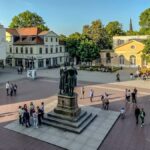
Weimar has about 65,000 inhabitants and is thus a medium-sized city by German standards. After Erfurt, Jena and Gera, Weimar is the fourth largest city in Thuringia. Around the city is the district "Weimarer Land" with small villages and a lot of agriculture. Weimar's center is compact and can be easily explored on foot.
Which sights are part of the UNESCO World Heritage Site "Classical Weimar"?
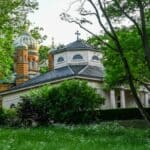
The "Classical Weimar" ensemble includes Goethe's residence on the Frauenplan, Schiller's residence, the Duchess Anna Amalia Library, the City Palace with the Bastille, the Wittum Palace, the City Church of St. Peter and Paul (Herder Church) with Herder House and Old Grammar School, the Prince's Crypt with the Historical Cemetery, the Park on the Ilm with Goethe's Garden House, Garden and Roman House, Belvedere Palace with Orangery and Palace Park, Tiefurt Palace and Palace Park, Ettersburg Palace and Palace Park.
Which sights in Weimar are part of the UNESCO World Heritage Site "Bauhaus and its Sites in Weimar, Dessau and Bernau"?

The Bauhaus sites in Weimar, which are a UNESCO World Heritage Site, are the former art school building (since 1996 the main building of the "Bauhaus-Universität Weimar") by Henry van de Velde, the former School of Arts and Crafts Weimar (van de Velde Building, since 1996 part of the Bauhaus University), also by Henry van de Velde, and the Haus am Horn by Georg Muche, Walter March and Adolf Meyer.
Which important persons have lived in Weimar?

Poets and philosophers: Johann Wolfgang Goethe, Friedrich Schiller, Johann Gottfried Herder, Christoph Martin Wieland, August von Kotzebue, Jean Paul, Arthur Schopenhauer, Friedrich Nietzsche, Gabriele Reuter, Rudolf Steiner
Musician: Johann Sebastian Bach, Franz Liszt, Johann Nepomuk Hummel
Artists and architects: Lucas Cranach the Elder, Lucas Cranach the Younger, Clemens Wenzeslaus Coudray, Adolf Donndorf, Henry van de Velde, Lyonel Feininger, Walter Gropius, Wassily Kandinsky, Paul Klee, Max Liebermann
(This list can only be incomplete!)
Hotel Recommendations for Weimar
Hotel Elephant Weimar, Autograph Collection (advertising link): The classic! Traditional 5-star hotel right at Weimar's market square (see also my comments on the Market Square).
Hotel Schillerhof (advertising link): Modern hotel in a quiet central location, 100 m from the German National Theater.
Boutique Hotel Amalienhof and Apartments (advertising link): Historic boutique hotel in Weimar's old town, 100 m from Goethe's Residence. Winter garden and roof terrace (overlooking Goethe's garden).
Art Hotel (advertising link) I stayed here during both of my four-day stays in Weimar and really liked it. The hotel is located in a villa district, very close to the Historical Cemetery, the Bauhaus University and the Park on the Ilm. Particularly noteworthy are the quiet location, the delicious breakfast and the free parking in front of the house. Only the low futon beds might not be everyone's cup of tea.
Restaurant and Café Recommendations for Weimar
Inn "Zum Weißen Schwan": Goethe's favorite pub is right on his doorstep and is correspondingly well frequented. With a beer garden and traditional hearty Thuringian cuisine. Frauentorstraße 23, 99423 Weimar, phone +49 (0) 3643 908751.
36 Pho Co: Creative, Vietnamese cuisine, casual atmosphere, near the marketplace. Marktstraße 1, 99423 Weimar, Tel. +49 (0) 3643 4684899
Sächsischer Hof: Traditional Thuringian cuisine in a rustic and cozy atmosphere at Herderplatz. There is also a beer garden. Medium price range. Eisfeld 12, 99423 Weimar, phone +49 (0) 3643 401384.
Café Frauentor: Beautiful bistro-café with a view of Schillerstraße and Frauenplan. Delicious cakes and a small but fine selection of dishes. Schillerstraße 2, 99423 Weimar, phone +49 (0) 3643 511322.
Residence Café and Restaurant: Weimar's oldest coffeehouse is a nice place inside and also on the terrace. The city palace and park on the Ilm River are just around the corner. Grüner Markt 4, 99423 Weimar, Tel: +49 (0) 3643 59408
Tips on How to Get to Weimar
Since Weimar is located in the middle of Germany, it is easy to reach from several international airports and from most places within Germany - whether by car or train.
Nearest airports:
To get from a major German city to Weimar by train, you always have to go to Erfurt first and change there to the regional train to Weimar. The train runs several times an hour and the trip only takes about 15 minutes.
The train journey from the Frankfurt and Berlin airports takes about 3 hours each, whereby you can board the train directly to Erfurt at the Frankfurt airport. In Erfurt, you only have to change to the regional train to Weimar, which runs several times an hour.
From Berlin you have one more change - you have to go from the airport to the train station Berlin Südkreuz and then change to the train to Erfurt.
By train:
Weimar unfortunately no longer has a long-distance train station, but that's not a bad thing because it's only 25 km from the state capital, Erfurt. Erfurt is easy to reach from all major German cities. Regional trains between Weimar and Erfurt run frequently and the trip takes only fifteen minutes.
By car:
Weimar is located directly on the A4 Frankfurt am Main - Dresden (about 5 km from the Freeway exit 49 Weimar to the city center). Therefore, it is easy to reach from all directions.
From the A71 (Würzburg, Schweinfurt), change to the A4 toward Dresden at the Erfurt intersection.
From the A9 (Berlin or Munich), take the A4 toward Frankfurt am Main at Hermsdorfer Kreuz.
Coming from the north (Flensburg, Hamburg, Hanover), take the A71 and change to the A4 towards Dresden at the Erfurt-Nord junction, exit B7.
Parking in Weimar
My tip for you: Do not go to the old town by carunless to park it in a hotel garage for the duration of your stay. I once made the mistake of driving my car into the city when I wanted to attend an evening performance at the German National Theater. With all the one-way streets and lack of parking, I almost missed the beginning of the performance, got flashed (zone 30!) and arrived rushed at the last minute. Just walking the 20 minutes from my hotel would have saved me time, money and nerves.
Large and easily accessible parking lots/underground garages are available on the edge of downtown:
- Underground parking under the Weimar Atrium (on the northern edge of the city center, very close to the Bauhaus Museum), access Ernst-Kohl-Straße, at the Gauforum.
- Underground parking garage Beethovenplatz (near Goethehaus), access via Wielandplatz and Ackerwand.
- Parking center cemetery, Berkaer Str. 2a, 10 minutes walk to the southern city center.
Public Transport Tips for Weimar
Weimar has a well-developed bus network that allows you to reach sights outside the city center, such as the Buchenwald Memorial and Belvedere Palace. The central bus hub is Goetheplatz, where electronic guidance systems inform you about departure times.
Bus tickets are available at Goetheplatz, in the Tourist Information website at Markt 10 and at the kiosk at the main station. As a user of the weimar card you ride free of charge.
If you want to use the public transport in Weimar, you can take the Ticket app of the public utility company Weimar on your cell phone. There you will find a network map and the current fares.
Weimar Card and Weimar Card Plus
The weimar card and the weimar card plus are tourist cards that give you free entrance to various sights and museums in the region.
Both tickets offer free admission to a variety of museums in Weimar and throughout the region, as well as discounted admission to events at the German National Theater and Kunstfest Weimar. A guided tour of the city by Weimar Tourist Information is also included, as well as Weimar's public transportation. The weimar card is valid for 48 hours and currently costs € 32.50 (as of 2023). There is also a weimar card plus for 96 hours at the price of € 59.50which includes a variety of museums in the region (even Wartburg Castle and Naumburg Cathedral!). Depending on how much time you have and what you want to see, one of these two tickets might be worth it for you.
Want to combine your visit to Weimar with other great places in Germany?
In my article about the 100 most beautiful places in germany I have listed Germany's most interesting travel destinations sorted by federal state. Let yourself be inspired!




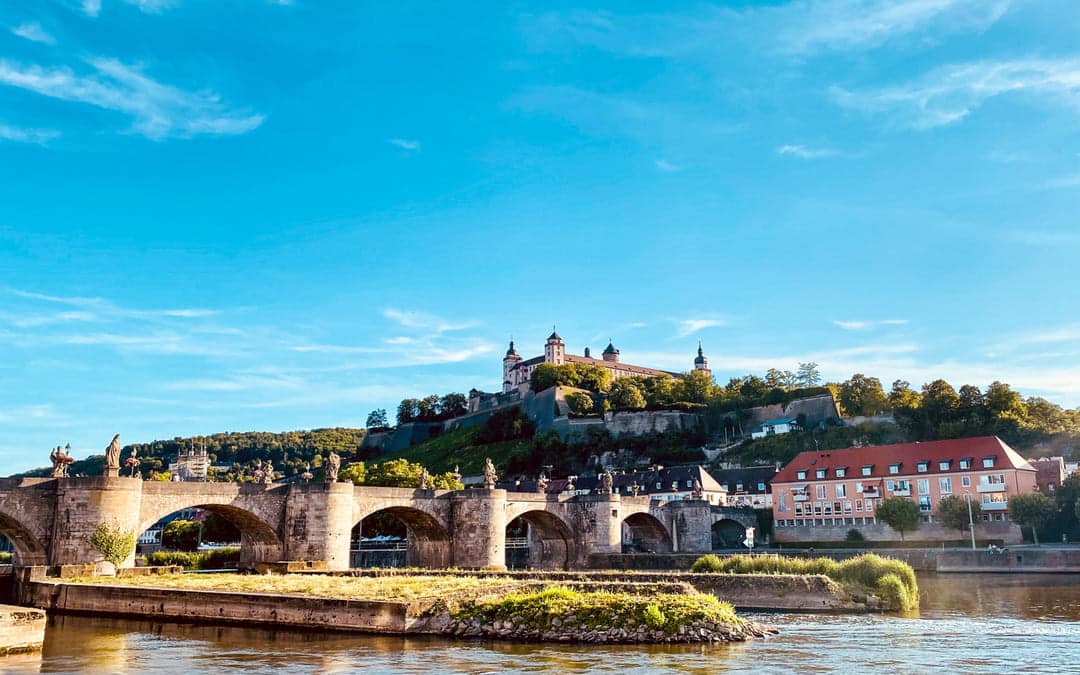
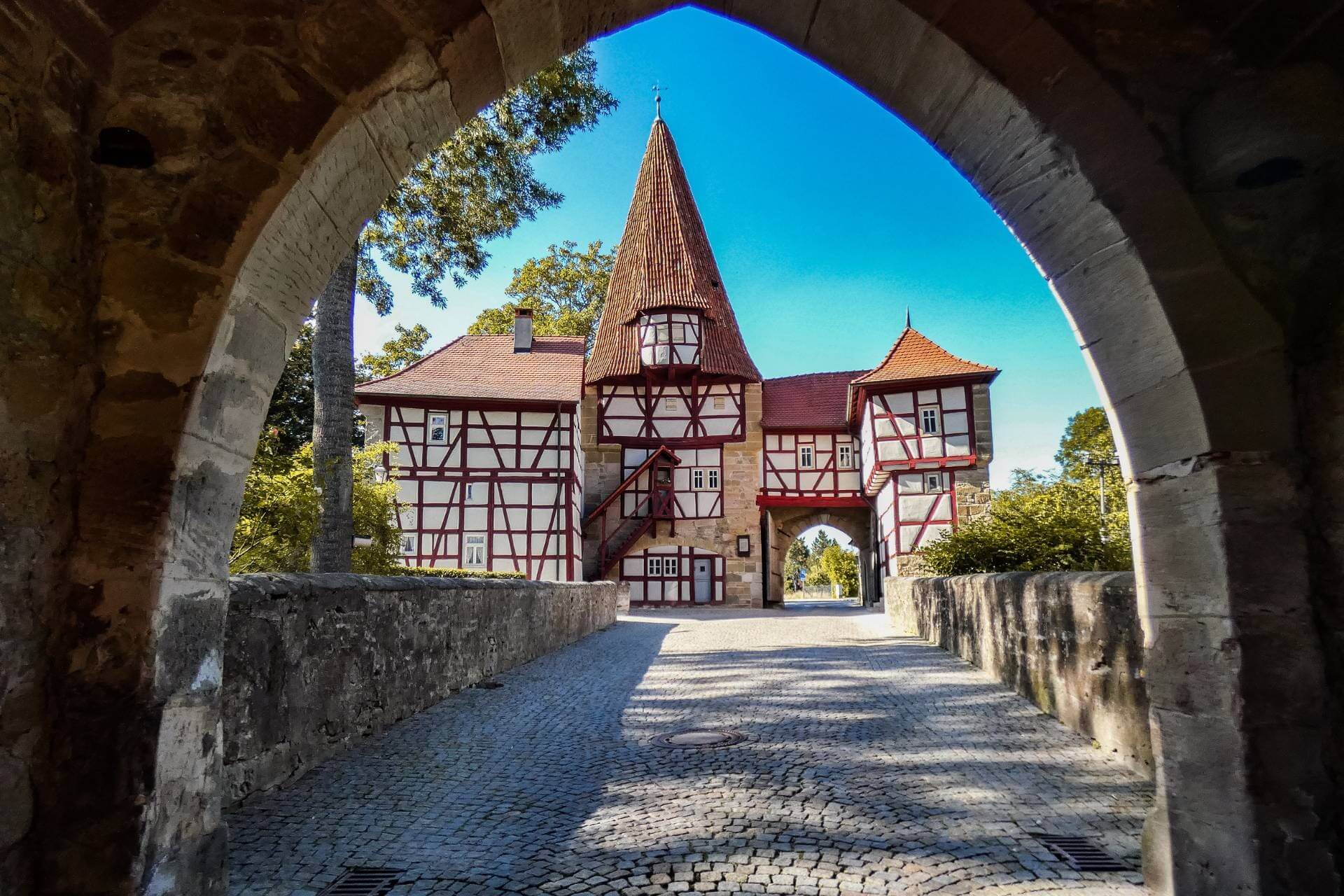


Trackbacks/Pingbacks